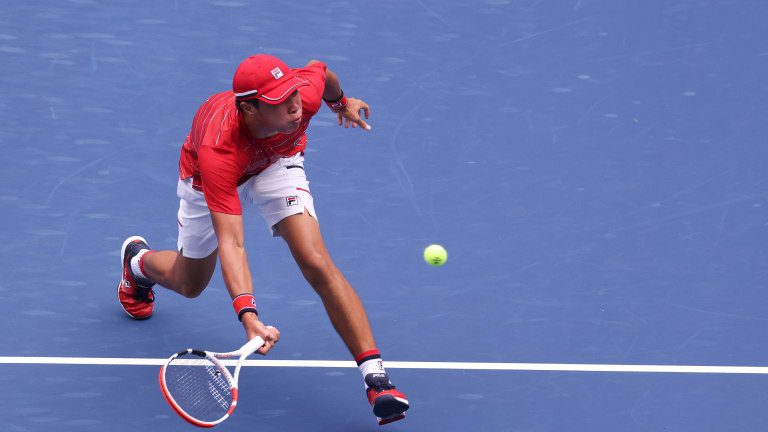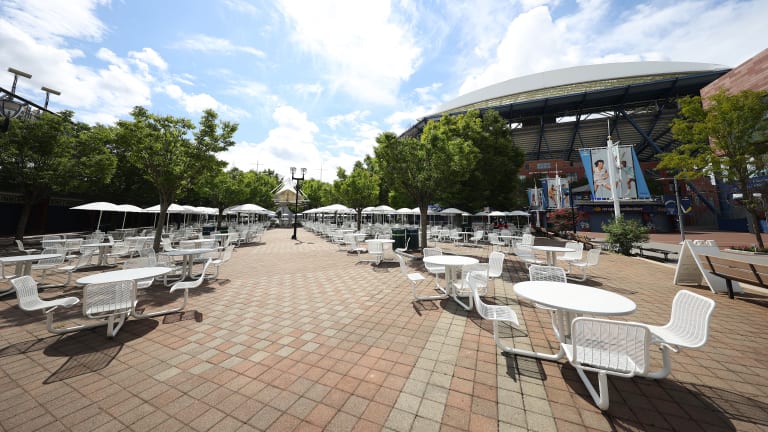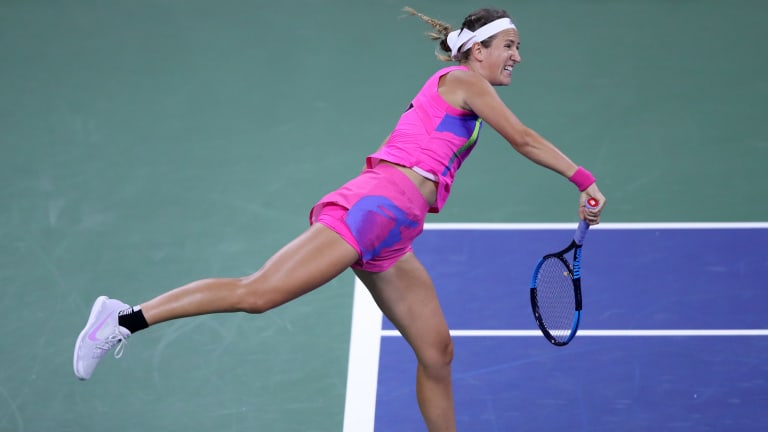US Open
The Rally: Thoughts on a closed US Open as we approach its second week
Sep 04, 2020US Open
Coco Gauff led the way, but it was a wildly successful US Open for American tennis at large
By Peter Bodo Sep 13, 2023US Open
Daniil Medvedev was stubborn to a fault at the US Open, but still came away a winner
By Peter Bodo Sep 13, 2023US Open
With the Grand Slam season in the books, what's the state of the ATP Tour in 2023?
By Joel Drucker Sep 12, 2023US Open
Four Grand Slam winners, five storylines: The state of the WTA in 2023
By Joel Drucker Sep 11, 2023US Open
Novak Djokovic put on one of his most impressive physical and tactical performances to win a 24th Grand Slam title
By Steve Tignor Sep 11, 2023US Open
Novak Djokovic wins the US Open for his 24th Grand Slam title by beating Daniil Medvedev
By Associated Press Sep 11, 2023US Open
Novak Djokovic has won 24 Grand Slam titles. Here is a look at each one
By Associated Press Sep 11, 2023US Open
Djokovic celebrates No. 24 with a tribute to Kobe Bryant, who wore that number and became a friend
By Associated Press Sep 11, 2023US Open
Novak Djokovic's US Open title gives him 24 Grand Slam titles. No one in tennis history has won more
By Associated Press Sep 11, 2023US Open
The Rally: Thoughts on a closed US Open as we approach its second week
During the second week, a Slam becomes a tennis tournament, but through the first week it can be much more.
Published Sep 04, 2020
Advertising
The Rally: Joel Drucker and Steve Tignor talk about how social issues play out at the first week of Grand Slams; how this Open feels like two legendary veterans trying to hold off a mass of young hopefuls; and what it’s like to cover all of it from outside the bubble.
Hi Steve,
As far as covering the US Open goes, I’m initially grateful and impressed.
To be sure, paying attention to the tournament from my house is a strange process. The multi-dimensional texture that accompanies being at an event is off the table. But given the state of the world, how fortunate to have the chance to comfortably do something like write about tennis.
It’s remarkable to see all the steps the USTA has taken to create a workable event. I’ve been in touch with several people inside the bubble. They’re staying safe and, as you can imagine, extremely focused.
The tennis itself has been fascinating, largely for two reasons. First, the lack of spectators has dramatically affected the ebb and flow of a given match. Whether it’s a great shot, long rally or match-shifting service break, to have any such drama capped off with silence must surely be disconcerting—both for experienced players who are used to it, but also for younger ones who’ve long dreamed about such moments. As I watched teenager Brandon Nakashima battle versus Alexander Zverev, I couldn’t help but wonder how it all would have gone had there been thousands of fans cheering on this promising young American.

The Rally: Thoughts on a closed US Open as we approach its second week
© Getty Images
Advertising
Brandon Nakshima. (Getty Images)
Reason number two is what I’ll call “The Freshness Factor.” We’ve heard how many players have spent this time away from competition working on their physical fitness. But how have they gone about staying competitively sharp? Did they play practice matches? I’m not just talking about a set or two here and there, but an all-out battle lasting at least three sets.
Roy Emerson once told me that to prepare for the arduous majors, he would play six-set practice matches. Along with this, what kind of intensity do players bring to practice sets? Jimmy Connors, the man who literally created visceral player-audience interaction, also once told me, “If you play every match like it’s the big match, you’re ready when the big match comes.”
Even then, of course, there will be staleness, as no practice situation can completely replicate the intensity of tournament play. This leads me to wonder: During this US Open, given how unseasoned all the players are, is it truly accurate to call any particular match outcome an upset? After all, it’s often been said that on a given day, anyone in the Top 100 can beat anyone. And now, having endured five months off the tour, isn’t every player pretty much a first-semester freshman? Or, as matches accumulate, will form start to hold up?
What’s struck you about this first week, Steve?
Hi Joel,
Emmo played six-set matches? Did that mean they needed to play a seventh set if the two players were tied after six? I don’t think best-of-seven would fly in this age of ever-shortening attention spans.
But it’s good to have best-of-five back, and the gravitas that comes with a Grand Slam. I wondered whether the Open would feel the like the Open, or whether it would just feel grim and obligatory without fans. So far it depends on the visual for me. When the camera pans out and I see the arenas in all of their static emptiness, I can’t pretend it’s not a bummer. But when the camera stays tight on the court, I feel most of the old tension and excitement, and sense the importance of the competition to the players. Even when there are no fans, the Open still feels like a world stage, and a place where stars are made. This week Naomi Osaka and Felix Auger Aliassime, in particular, have taken it over at night, in a profile-raising way.
Covering the Open from home, especially when I’m just a few miles away in Manhattan, is obviously strange. First, there are no players or out-of-town fans roaming my east-side neighborhood, which they normally do at this time of year. I miss walking past my local Starbucks and getting to say, “Hey, isn’t that Aleksandra Krunic!?” All of that extra, late-summer US Open energy, which is like a jolt of wholesome Middle American-ness in the heart of the city, is gone this year. It’s just the locals here now.
Advertising

The Rally: Thoughts on a closed US Open as we approach its second week
© Getty Images
An eerily empty food court at the USTA Billie Jean King National Tennis Center. (Getty Images)
As you know, Joel, maybe the biggest benefit of being on site isn’t so much the access to the players—which is tightly controlled during majors—but the chance to talk to journalists from other countries who can give you details and insights on the pros from their nations. In recent years, I’ve sat near the Spanish journalists in the Open’s press room, and learned more about, say, Garbiñe Muguruza from chatting with them and overhearing them than I have anywhere else. There’s a texture to a tournament, in its details, that you can only sense when you’re there.
But Zoom press conferences aren’t as bad as we might have thought a few months ago. You can see the players and hear your fellow journalists, just like you can when you’re in the interview room on site. The only glitch I’ve noticed came at the start of an Angelique Kerber presser on the first day of the tournament. It began with a few seconds of dead air, as a reporter tried to unmute himself and ask a question. Kerber finally turned to a USTA official and said, “I can’t hear nothing.”
Who has impressed you most so far, Joel? I guess I’ve realized more than ever before how the first week of a Grand Slam, and especially the Open, has become a time when social issues play out on the court. Sometimes tennis leads the progressive charge, other times it brings up the rear guard.
So far this year we’ve talked about gender, in the increased success of moms on the WTA tour. We talked about race, with Osaka starting to school her European counterparts on the Black Lives Matter movement. We’ve talked about labor relations, with the mini-uproar over Novak Djokovic’s new, men’s-only player union. And of course the whole tournament has been played in the shadow of the pandemic, which is the overarching issue everywhere. During the second week, a Slam becomes a tennis tournament, but through the first week it can be much more.
Advertising
Steve,
It’s clear from these early days at the US Open that a lot of players took their time away from the traveling tennis circus to train very hard.
You mentioned Osaka and Auger-Aliassime, each of whom has played excellent tennis thus far. I think Osaka’s increasing social consciousness has also made it easier for her to go about playing. Others who’ve struck me include familiar faces Sofia Kenin, Madison Keys, Frances Tiafoe and Daniil Medvedev—such a pleasing range of playing styles. And then, in addition to Nakashima, there are young American prospects J.J. Wolf, Ann Li, Caty McNally and Katrina Scott.
My nomination for the heartwarming tale of week one has been the performances of a trio of mothers. Serena Williams’ form has picked up with each set she’s played. Then there’s Tsvetana Pironkova, back after three years away. But the mother I’ve been most impressed with is 31-year-old Victoria Azarenka. Here she is, thoroughly enjoying herself and showing off the smothering movement and accurate groundstrokes that once made her number one in the world. After beating fellow Belarussian Aryna Sabalenka last night, Azarenka spoke thoughtfully in her post-match press conference, addressing her emotional journey and the new approach she’s been taking to tennis. No question, motherhood and the pandemic have helped her view life and tennis quite differently. It’s refreshing.

The Rally: Thoughts on a closed US Open as we approach its second week
© Getty Images
Advertising
Victoria Azarenka, the Western & Southern Open champion, looks like a title contender at the US Open. (Getty Images)
So the tennis itself continues as captivating. With each passing day, we get used to the courtside atmosphere, be it the empty stands, the lack of noise, and, inside Arthur Ashe Stadium, the player suites. But then the match gets underway and it’s time to compete. I’ll be curious to hear from players what they learned playing Grand Slam matches in such conditions.
As I write this, I see tennis possibly entering a new phase. The pandemic. Social activism. Parenthood. No spectators. All of these global, perspective-laden facets should surely give the entire sport a new view of itself as this new decade continues.
Still, for all that, like you, Steve, I miss the peripheral but compelling New York City dimension. The first time I attended the tournament was in 1978, the summer after I graduated from high school and drove with a friend from Los Angeles to New York. Over these 40 years, I’ve come to associate the US Open and New York City with a variety of sights, sounds, smells and, most of all, tastes. All those little things, be it New York pizza, bagels and bakery treats, or certain restaurants I’ve dined at with friends, all mixed in with the tennis.
Steve, what are you looking forward to as the second week gets underway?
Joel,
As I said above, the second week of a Slam becomes more about tennis and less about the issues that play out around it. I like that downshift, and that sense that you’re getting to know each player who survives a little more with every match they win.
On the women’s side, I’m looking forward to seeing, first, how Serena’s quest for 24 goes. She seems very dialed in mentally so far, as you’d expect. Can she maintain a balance between staying focused, and not making herself too tense, as she has in recent Grand Slam finals? She’s obviously going for it in a big way right now. Is there anyone who will be able to stop her?
On the men’s side, I’m looking forward to getting a feel for what the ATP tour might start to look like in a world without Roger Federer and Rafael Nadal. So far the Next Gen heirs—Zverev, Thiem, Tsitsipas, Medvedev, Berrettini, Rublev, Khachanov, Auger Aliassime, Fritz, Shapovalov—have acquitted themselves well. Who’s ready to go all the way and challenge Djokovic?
That seems to be where we are on both tours right now: There’s one legendary veteran trying to hold off a mass of younger hopefuls. In other words, the past and present are trying to hold off the future for a little longer. That should be dramatic enough to satisfy us, even if there’s no one to see it happen in person.